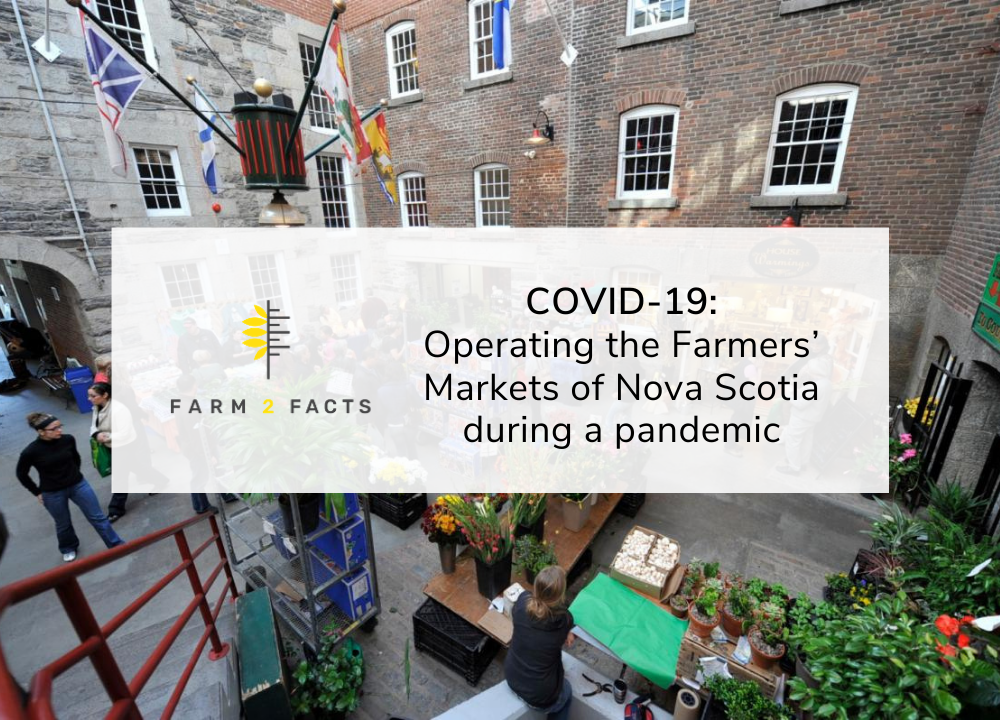
Justin Cantafio, the executive director of the Farmer’s Markets of Nova Scotia Cooperative, discussed how the non-profit cooperative has helped the market vendors and customers stay safe and increased market accessibility during the pandemic, the difference between the structure of markets in Canada (particularly Nova Scotia) and the United States, and highlighted the importance of farmer’s markets for the economy.
- How have you helped the Nova-Scotia markets adapt to COVID?
- Can you describe how your marketing grants help markets and BIPOC-owned businesses?
- How do farmer’s markets help local economies?
- How do economic structures differ in Canada from the United States or the rest of the world? How about farmers markets?
Since early 2020, the Farmers’ Markets of Nova Scotia Cooperative (FMNS) has worked tirelessly to mitigate the impacts of COVID-19 on the province’s farmers’ market sector. Since March, FMNS has helped Nova Scotia become the first province or state in North America to create a province-wide cohort of online farmers’ markets, released up-to-date health and safety directives for the sector, hosted webinars with our member farmers’ markets, created guides to federal and provincial funding opportunities, and worked one-on-one to help our markets and vendors adapt to constantly shifting market conditions. We’ve created grants and resources, and radically altered our cooperative’s activities to help our sector persevere through these challenging times.
With the exception of a small handful of FMNS’ 38 farmers’ markets, virtually every one is operating in some capacity. FMNS acknowledges that social distancing requirements may have changed the layout, look, and feel of many of our markets, but there are so many beautiful, incredibly important farmers’ markets in operation right now in Nova Scotia. And they need our public support now more than ever. A map of these markets can be found by clicking here.
FMNS has also significantly expanded our Nourishing Communities Food Coupon Program to support vulnerable households, created and issued funding support (money to cover the cost of creating online stores, marketing grants for farmers’ markets and BIPOC-owned businesses, and adaptation grants for sanitizer, PPE, signage, coolers, tables, and more), hosted support webinars, advocated on behalf of the sector as a whole, increased our promotional activities substantially, and are in the process of creating a mental health support program specifically for the farmers’ market sector. We’ve done all of this to make sure that our farmers’ markets can continue operating, adapt, and have the biggest impact possible during these challenging times.
Our Market(ing) Grant was designed specifically for farmers’ markets to get the word out that they’re still operational. This is incredibly important, as the look, shape, and feel of farmers’ markets in Nova Scotia have changed substantially as our markets and their vendors have adapted to constant change.
We realized that the social and economic impacts of the disruption caused by COVID-19 ultimately disproportionally affects BIPOC folx in Nova Scotia and throughout Canada, and we wanted to mobilize some of our funds to address that issue by offering the same Market(ing) grant that we offered to markets, to BIPOC-owned farmers’ market businesses.
This grant has allowed for the advertising, marketing, and promotional activities that might otherwise have been cost-prohibitive. Up to $200 has been granted to each Market(ing) Grant recipient.
Our cooperative’s member farmers’ markets are small business incubators, job creators, and hubs for social and economic activity. They’re the places where producers and vendors sell directly with their target market, where entrepreneurs find a low-overhead venue to create and develop their minimum viable product, where artisans showcase and sell their wares, and where new Canadians ply their trade. Our cooperative’s farmers’ markets are also a driving force in Nova Scotia’s buy-local movement and the trendsetters that launched and continue to bolster the province’s thriving agri-tourism industry.
Our farmers’ markets create opportunities for economic recirculation of our dollars—the economic multiplier effect of dollars staying in our communities. Nova Scotia has the most farmers’ markets per capita of any province or territory in Canada. We also have the most microbreweries per capita in Canada, and it’s no secret that many got their start selling at farmers’ markets.
Another way our cooperative impacts our local economies is through our Nourishing Communities Food Coupon Project. The project involves FMNS member farmers’ markets and partner social organizations working together to increase food security for low-income Nova Scotians while supporting local producers and farmers. This program allows project participants to use an anonymous alternative currency—or “food bucks”—that can be redeemed at any vendor stall at participating markets.
This year’s program is providing weekly food bucks allotments to well over 200 households across Nova Scotia. Now in our second year, FMNS has expanded this project from 6 participating farmers’ markets to 13, with over 20 partner organizations, such as food banks and shelters.
Both Canada and the United States are federations, meaning that our provinces or states have some level of independent self-governance. In the United States, many states have state-wide farmers’ market sector associations, while there are only a handful amongst Canada’s provinces and territories. Farmers’ Markets of Nova Scotia is the only farmers’ market sector association east of Ontario.
Farmers’ markets in Nova Scotia deal with a few unique characteristics, mainly the geographical isolation. In Nova Scotia, you can’t possibly ever get further than a 30-minute drive from the ocean, but to drive East/West from one side of the province to the other would take over 10 hours. In fact, some parts of Nova Scotia are so isolated that even Hollywood has taken notice. At the closing scene of 2013’s blockbuster zombie thriller World War Z, Brad Pitt’s character is seen pensively staring off into the distance in what is presented as the last military stronghold left on the entire zombie-ridden planet. The hero’s location? The tiny village of Freeport, located on a small island in the Bay of Fundy, two ferry rides from the mainland. Even Hollywood knows Nova Scotia has a funky geography.
But despite this and with a population of less than a million people, we still have over 50 farmers’ markets. It’s certainly a challenge to ensure that all these markets have fresh produce year-round, and indeed many of our markets are seasonal. Nova Scotia has a more maritime climate than interior Canada, but we’re still hit by bitterly cold and wet winters, meaning outdoor markets can only happen for a few months of the year, unlike many parts of the United States and even some regions of Canada’s Pacific coast.
Follow along with NSFM on facebook for market updates and farming information!

